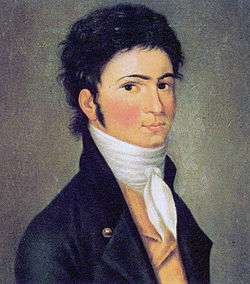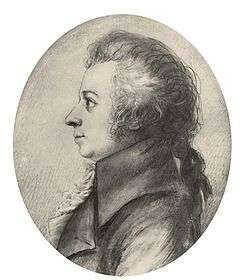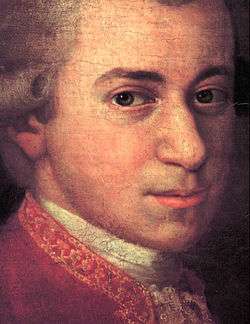Beethoven and Mozart

Wolfgang Amadeus Mozart had a powerful influence on the work of Ludwig van Beethoven. They are said to have met in Vienna in 1787, and Beethoven is said to have had a few lessons from Mozart. However, this is uncertain, as there is only one account of a meeting, and it is not contemporary. Beethoven knew much of Mozart's work. Some of his themes recall Mozart's, and he modeled a number of his compositions on those of the older composer.
Beethoven's years in Bonn
Beethoven was born in Bonn in 1770, about 14 years after Mozart was born (1756) in Salzburg. In 1781, during Beethoven's childhood, Mozart had moved to Vienna, the Austrian imperial capital, to pursue his career. Bonn was politically and culturally affiliated to Vienna,[1] but Vienna was geographically remote, on the opposite side of German-speaking Europe.[2]
During his youth and musical training in Bonn, Beethoven had extensive, intimate exposure to Mozart's music. He played Mozart piano concertos with the Bonn court orchestra and performed (playing viola) in Mozart's operas. Indeed, Lewis Lockwood writes, "Just as Mozart had once told his father that he was 'soaked in music', so Beethoven was soaked in Mozart."[3] In Beethoven's early efforts to compose, he was so strongly inspired by Mozart that once he worried that he had plagiarized him by mistake. Lockwood writes:
On a sketch leaf from about October 1790 Beethoven wrote down a brief C-minor passage in 6/8 meter, in two-staff piano score, and then wrote down these words, between the staves, about the little phrase: 'This entire passage has been stolen from the Mozart Symphony in C, where the Andante in six-eight from the ...' (he breaks off here). Then Beethoven writes the passage again just below and a little differently, on the same sketch page, and signs it 'Beethoven himself'. The passage he thought he was quoting cannot traced to any Mozart symphony that we know.[4]
The Vienna visit

Beethoven visited Vienna early in 1787, but accounts differ as to the exact dates. Cooper states that he arrived in early April and left about three weeks later.[5] Haberl says that he arrived in January 1787 and departed in March or April, remaining in the city for up to 10½ weeks.[6] There is evidence for this in the Regensburgische Diarium.[7] Beethoven's return to Bonn was prompted at least in part by his mother's medical condition (she died of tuberculosis in July of that year[8]). His father was nearly incapacitated by alcoholism, and Beethoven had two younger brothers, so he may have needed to go home to help support his family.
Written documentation of Beethoven's visit is thin. The two composers may have met; Haberl's dates imply a period of about six weeks when this could have occurred[6] (Mozart was in Prague for part of early 1787). There are various views as to what happened during the visit. The 19th century biographer Otto Jahn gives the following anecdote:
Beethoven made his appearance in Vienna as a youthful musician of promise in the spring of 1787, but was only able to remain there a short time; he was introduced to Mozart, and played to him at his request. Mozart, considering the piece he performed to be a studied show-piece, was somewhat cold in his expressions of admiration. Beethoven, noticing this, begged for a theme for improvisation, and, inspired by the presence of the master he revered so highly, played in such a manner as gradually to engross Mozart's whole attention; turning quietly to the bystanders, he said emphatically, "Mark that young man; he will make himself a name in the world!"[9]
Jahn does not say where he got this from, mentioning only that "it was communicated to me in Vienna on good authority". No contemporary document (such as a letter written by Beethoven or Mozart or a reminiscence of any of Beethoven's contemporaries) corroborates the story, and contemporary scholarship seems reluctant to propagate it. The New Grove Dictionary of Music and Musicians does not mention it; its account of the visit is as follows:
In the spring of 1787 Beethoven visited Vienna. In the absence of documents, much remains uncertain about the precise aims of the journey and the extent to which they were realized; but there seems little doubt that he met Mozart and perhaps had a few lessons from him.[10]
Maynard Solomon, who has written biographies of both Mozart and Beethoven, does not mention Jahn's tale, and even puts forward the possibility that Mozart might have given Beethoven an audition and then rejected him:
In Bonn Beethoven was being groomed to be Mozart's successor by [a group of influential nobles], who sent him to Vienna ... to advance that purpose. The sixteen-year-old Beethoven, however, was not yet ready to be on his own. At his father's urging, the young virtuoso left Vienna ... and returned home in a state of despondency over his mother's consumptive condition – and perhaps over a rejection by Mozart, who was preoccupied with his own affairs, including his worrisome financial condition, and may not have been able seriously to consider taking on another pupil, even one of great talent and backed by eminent patrons.[11]
Solomon goes on to enumerate other matters that kept Mozart preoccupied at the time: his father's declining health, a visit to Prague, the beginnings of work on Don Giovanni, and the writing of "a vast amount of other music". Moreover, Mozart already had a pupil living in his home, the nine-year-old Johann Nepomuk Hummel.
A hypothesis compatible with all the documentary evidence except Jahn's unsourced report is that Mozart and Beethoven simply never met.[12]
While it cannot be determined whether Beethoven met Mozart, it does seem likely that he heard Mozart play. Beethoven's student Karl Czerny told Otto Jahn that Beethoven had told him that Mozart (whom Beethoven could only have heard in 1787) "had a fine but choppy [German zerhacktes] way of playing, no ligato."[13]
Regardless of whether Beethoven met Mozart in Vienna, his 1787 visit there seems to have been the start of an unhappy time for him. The Grove Dictionary notes that his "first surviving letter, to a member of a family in Augsburg that had befriended him on his way [to Vienna], describes the melancholy events of that summer and hints at ... ill-health [and] depression.[10]
Shared experiences
Beethoven eventually returned to Vienna in 1792, the year after Mozart's death. His early years in Vienna include many experiences similar to Mozart's own in the preceding years, and he became closely acquainted with some of Mozart's associates. In particular, like Mozart, Beethoven early established a strong reputation as keyboard performer, was mentored by Joseph Haydn, and was patronized by Countess Maria Wilhelmine Thun. Beethoven was also patronized by Baron van Swieten, in whose home he played the works of Baroque masters, just as Mozart had done. Like Mozart, Beethoven traveled (in 1796) to Prague, Dresden, Leipzig, and Berlin in the company of Prince Lichnowsky. On the Prague phase of his journey, Beethoven composed an extended concert aria for the noted soprano Josepha Duschek, as Mozart had done on his visit in 1789.[14] By the early 19th century Beethoven was a focus of Emanuel Schikaneder's attention; the impresario sponsored the sketch phases of Beethoven's intended opera Vestas Feuer, just as he had been the impetus for Mozart's The Magic Flute. (Beethoven eventually abandoned Vestas Feuer in favor of Fidelio.)
Influence of Mozart on Beethoven
Mozart's influence was apparent in the works of Beethoven even after his death. For example, Beethoven copied a passage from Mozart's 40th Symphony into the sketchbook he was using when he composed his Fifth Symphony, the third movement of which opens with a theme similar to one from the Mozart. Charles Rosen sees Mozart's C minor Piano Concerto, K. 491, as a model for Beethoven's 3rd Piano Concerto in the same key,[15] the Quintet for Piano and Winds, K. 452, for Beethoven's quintet for the same instruments, Op. 16,[16] and the A major String Quartet, K. 464, for Beethoven's A major String Quartet Op. 18 No. 5.[16] Robert Marshall sees Mozart's Piano Sonata No. 14 in C minor, K. 457, as the model for Beethoven's "Pathétique" Sonata, Op. 13, in the same key.[17]
Beethoven wrote cadenzas (WoO 58) to the first and third movements of Mozart's D minor piano concerto, K. 466, and four sets of variations on themes by Mozart:
- on "Se vuol ballare" from The Marriage of Figaro, for piano and violin, WoO 40 (1792–3);
- on "Là ci darem la mano" from Don Giovanni, for two oboes and cor anglais, WoO 28 (?1795);
- on "Ein Mädchen oder Weibchen" from The Magic Flute, for piano and cello, Op. 66 (?1795);
- on "Bei Männern welche Liebe fühlen" from the same opera, for piano and cello, WoO 46 (1801).[18]
Notes
- ↑ It was capital of a small state whose ruler, after 1784, was the younger brother of the Austrian emperor.
- ↑ The distance by road was probably over 500 miles (about 800 kilometers); see .
- ↑ Lockwood (2003:56)
- ↑ Lockwood (2003:56-57)
- ↑ Cooper (2008), p. 23
- 1 2 Haberl (2006), pp. 215–55
- ↑ Hoyer (2007)
- ↑ Kerman et al., section 2; Deutsch 1965, 288
- ↑ Jahn (1882), p. 346. Translation by Pauline Townsend, slightly altered.
- 1 2 Kerman et al., section 2
- ↑ Solomon (1995), p. 395
- ↑ Clive (1993), p. 22. Eisen, in his notes to Abert's biography of Mozart, endorses this skepticism.
- ↑ Alexander Wheelock Thayer, Elliot Forbes, Hermann Deiters, Hugo Riemann, Henry Edward Krehbiel (1991) Thayer's Life of Beethoven, Volume 1. Princeton: Princeton University Press. Extract available on Google Books at .
- ↑ Mozart's aria was "Bella mia fiamma, addio," K. 528, Beethoven's Ah! perfido, Op. 65.
- ↑ Rosen (1997), pp. 390, 450
- 1 2 Rosen (1997), p. 381
- ↑ Marshall (2003), pp. 300–301
- ↑ Clive (1993), p. 22
References
- Clive, Peter (1993). Mozart and his circle: a biographical dictionary. New Haven: Yale University Press. ISBN 978-0300059007.
- Cooper, Barry (2008). Beethoven. Oxford University Press US. ISBN 978-0-19-531331-4.
- Deutsch, Otto Erich (1965). Mozart: A Documentary Biography. Peter Branscombe, Eric Blom, Jeremy Noble (trans.). Stanford: Stanford University Press. ISBN 978-0-8047-0233-1. OCLC 8991008.
- Haberl, Dieter (2006). "Beethovens erste Reise nach Wien – Die Datierung seiner Schülerreise zu W. A. Mozart". Neues Musikwissenschaftliches Jahrbuch. 14: 215–55.
- Hoyer, Johannes (2007). "Wann reiste Beethoven erstmals nach Wien?". Archived from the original on 10 June 2007.
- Jahn, Otto (1882) [1856]. Life of Mozart. Translated by Pauline Townsend. Oxford University Press. Viewable online at Google books.
- Joseph Kerman. "Beethoven, Ludwig van". In L. Root, Deane. Grove Music Online. Oxford Music Online. Oxford University Press. (subscription required)
- Lockwood, Lewis (2003) Beethoven: The music and the life. New York: W. W. Norton.
- Marshall, Robert Lewis (2003). Eighteenth-century keyboard music. Routledge. ISBN 978-0415966429.
- Rosen, Charles (1997). The Classical Style: Haydn, Mozart, Beethoven. New York: W.W. Norton. ISBN 978-0393040203.
- Solomon, Maynard (1995). Mozart : a Life. New York, NY: HarperCollins. p. 395. ISBN 0-06-019046-9.
- Solomon, Maynard (2001). Beethoven (revised ed.). Random House. ISBN 978-0091794361.
